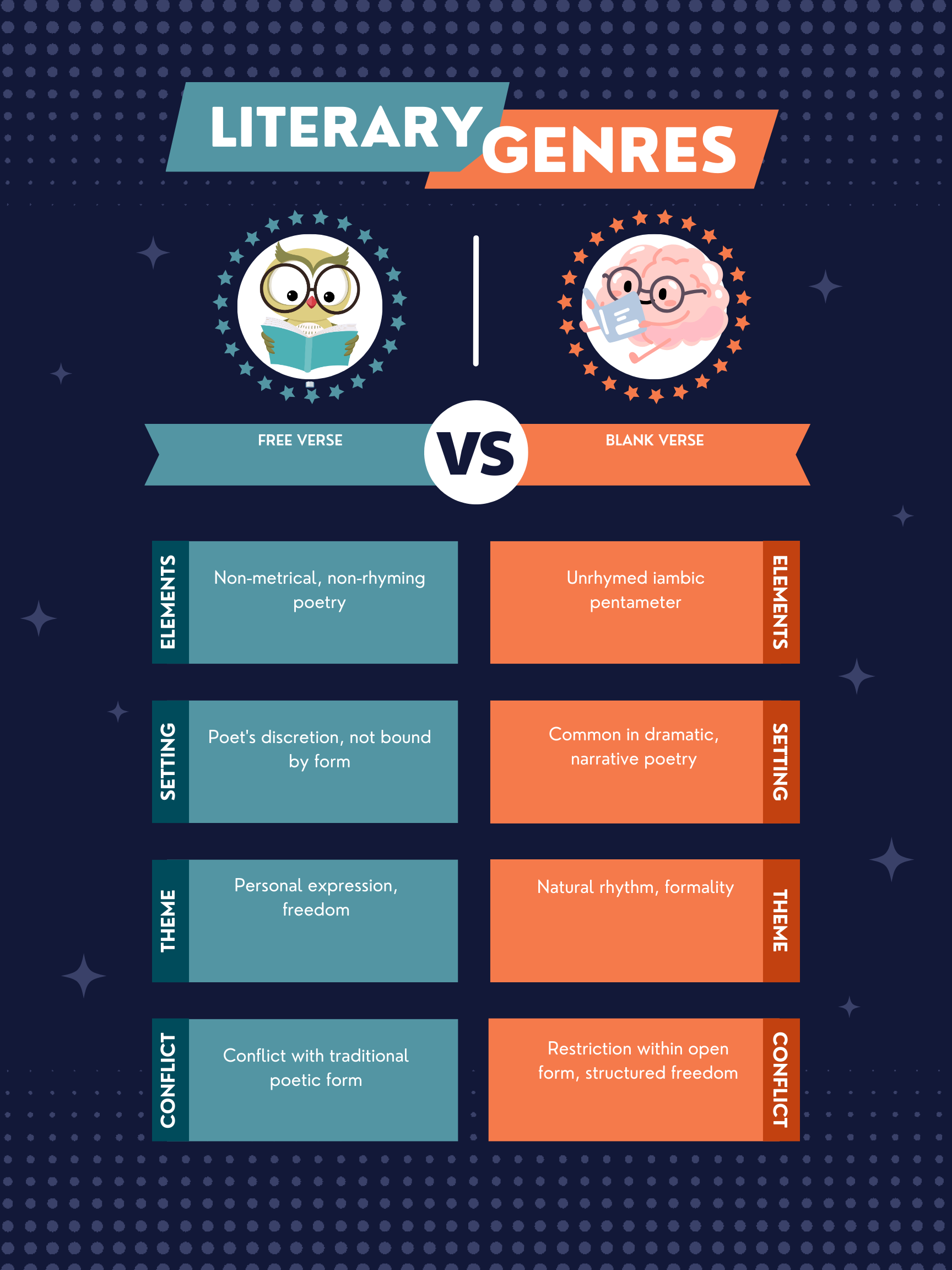Free Verse poetry lacks consistent meter patterns, rhyme, or any musical pattern, allowing freedom in form; Blank Verse is unrhymed poetry but maintains a consistent meter, usually iambic pentameter.
In the vast ocean of poetry, free verse and blank verse stand out for their unique approaches to rhythm and structure, offering poets diverse tools for expression. 📝🌊
Free Verse
Free verse poetry eschews traditional metrics, rhyme schemes, and musical patterns, granting the poet complete freedom in crafting verses. This form allows for a more natural flow of language, mirroring the cadences of speech. Walt Whitman’s “Leaves of Grass” is a seminal work of free verse, celebrating the individual and the natural rhythms of the human voice.
Blank Verse
Blank verse retains a structured metrical pattern, usually iambic pentameter, but does not rhyme. This form combines the musicality of meter with the flexibility of unrhymed poetry, making it suitable for dramatic monologues and expansive narrative poems. William Shakespeare’s plays, such as “Hamlet,” extensively use blank verse, providing a rhythmic yet open canvas for dialogue.
Summary
| Literary Device | Definition | Purpose | Usage | Relevant Examples |
|---|---|---|---|---|
| Free Verse | Poetry without a consistent meter, rhyme, or pattern. | To mirror natural speech, offering creative freedom. | Poetry that emphasizes personal expression and natural speech rhythms. | “Leaves of Grass” by Walt Whitman. |
| Blank Verse | Unrhymed poetry with a consistent meter (usually iambic pentameter). | To maintain a musical quality while allowing flexibility in expression. | Dramatic monologues, narrative poems, plays. | Shakespeare’s plays like “Hamlet.” |
Writing Tips
For Free Verse:
- Embrace Flexibility: Let your theme or message guide the structure of your poem.
- Use Line Breaks Wisely: Even without meter or rhyme, line breaks can create rhythm, emphasis, or a visual layout that supports your poem’s themes.
- Be Intentional: Every word, line, and break should serve a purpose, whether it’s to evoke an image, emotion, or thought.
For Blank Verse:
- Master the Meter: Familiarize yourself with iambic pentameter to maintain a rhythmic foundation.
- Vary Within Structure: Use enjambment, caesuras, and varied sentence lengths to introduce variety within the constraints of meter.
- Focus on Sound: Even without rhyme, the sound of words and the flow of the meter can enhance the poem’s emotional and aesthetic impact.
FAQs
Can a poem combine free verse and blank verse?
While uncommon, a poem could theoretically transition between free verse and blank verse to achieve specific effects or emphasize contrasts.
Why choose blank verse over free verse?
Blank verse may be chosen for its rhythmic quality and formal structure, which can lend a sense of gravity or solemnity to the text, making it particularly effective for dramatic works or narratives.
Exercise
Read the following excerpt: “The wind whispers through the empty halls, a silent witness to years gone by. In its breath, stories unfold, untold, unheard.”
Answer: This passage suggests free verse due to the lack of a consistent metrical pattern or rhyme scheme, focusing instead on natural speech rhythms and imagery.
Other Interesting Literary Device Comparisons
- Narrative Poetry vs Lyric Poetry: Narrative poetry tells a story with characters and a plot, while lyric poetry expresses personal thoughts and feelings.
- Sonnet vs Haiku: Both are structured poetic forms, but sonnets are 14-line poems with a specific rhyme scheme, usually in iambic pentameter, whereas haikus are 3-line poems with a 5-7-5 syllable pattern, focusing on nature and the moment.
- Epic vs Elegy: Epics are long narrative poems about heroic deeds and adventures, often involving gods or legendary heroes, while elegies are mournful poems lamenting the dead.
Exploring these differences enriches our understanding of poetry’s vast landscape, offering endless possibilities for expression and connection. 📘💫

